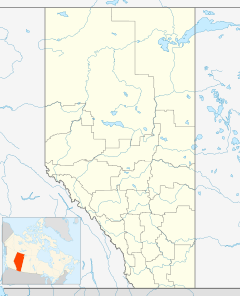Glenwood, Alberta facts for kids
Quick facts for kids
Glenwood
|
|
|---|---|
|
Village
|
|
| Village of Glenwood | |
| Country | Canada |
| Province | Alberta |
| Region | Southern Alberta |
| Census division | 3 |
| Municipal district | Cardston County |
| Incorporated | |
| • Village | January 1, 1961 |
| Area
(2021)
|
|
| • Land | 1.37 km2 (0.53 sq mi) |
| Population
(2021)
|
|
| • Total | 272 |
| • Density | 197.9/km2 (513/sq mi) |
| Time zone | UTC−7 (MST) |
| • Summer (DST) | UTC−6 (MDT) |
| Postal code span |
T0K 2R0
|
| Highways | Highway 810 Highway 505 |
| Waterways | Belly River |
Glenwood is a small village located in southern Alberta, Canada. It sits just north of the Town of Cardston, within Cardston County.
Glenwood was named after Edward Glen Wood. The person who founded the village was Edward J. Wood. He took over from Charles Ora Card, who was the founder of Cardston and an important leader in the Latter Day Saint faith. Both Edward Glen Wood and Edward J. Wood came from Salt Lake City, Utah. They are both buried in Cardston. Before 1979, the village was known by a slightly different name: Glenwoodville.
How Many People Live in Glenwood?
This section tells us about the number of people living in Glenwood. It also looks at how the population has changed over time.
Population in 2021
In 2021, a count of the population was done by Statistics Canada. This count is called the 2021 Census of Population. It showed that 272 people lived in the Village of Glenwood. These people lived in 104 homes out of 124 total homes available.
The population in 2021 was a bit smaller than in 2016. It changed by about 14% from the 2016 population of 316 people. Glenwood covers an area of 1.37 square kilometres (0.53 square miles). This means there were about 198 people living in each square kilometre in 2021.
Population in 2016
In the 2016 Census of Population, Glenwood had 316 residents. They lived in 107 of the 119 available homes. This was an increase of about 10% from its 2011 population of 287 people. The village's land area was 1.37 square kilometres (0.53 square miles). In 2016, there were about 231 people per square kilometre.


